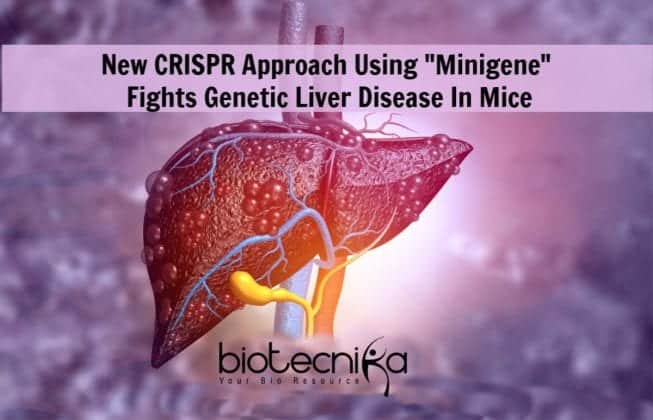CRISPR “Minigene” By Penn Researchers Against Genetic Liver Disease
A wide range of genetic liver diseases could be treated using the CRISPR gene-editing tool, suggests Penn Study.
Penn Medicine researchers reported that a genetic liver disease known to be driven by several different mutations can be prevented by a new CRISPR gene-editing technique, using which, improved clinical symptoms in mice were observed. Treating patients with hereditary diseases triggered by different mutations on the same gene or with a rare metabolic urea-cycle disorder caused by a deficiency the enzyme, ornithine transcarbamylase (OTC), CRISPR could potentially be a promising tool.
The Study
This new CRISPR approach builds off the one developed at Penn Medicine previously. The one developed earlier benefitted only newborn mice, did and benefit adult mice and it could correct only one mutation. The new technique employs a novel, dual adeno-associated virus (AAV) to deliver its components and to accomplish a sustained expression of OTC in the liver cells, a “minigene” was inserted into the genome, in an approach known as a “cut” and “paste” approach. A new set of instructions was added to the cells rather than correcting the mutations. In newborn mice, a clinical benefit that continued into adulthood was observed as a result.
The director of the Gene Therapy Program and the Orphan Disease Center at Penn and a professor of Medicine, James Wilson, MD, Ph.D. said, ” In newborns, most genetic diseases present lethal effects and thus early treatments that are effective for the long term are essential. Not just to sustain the expression of OTC in the cells but also to broaden the tool’s abilities, we moved ahead with this CRISPR approach. Eventually treating patients with OTC disorders and other genetic diseases caused by mutations scattered throughout the gene by translating this gene-editing approach from animals, is our goal.”
On the OTC gene, there can be more than 300 different caused by the OTC disorder. It is typically found in males since those mutations occur on the X chromosomes. A series of six liver enzymes help the body to get rid of ammonia in the urea cycle. There can be brain damage or even death caused when one of those enzymes is missing or deficient which causes ammonia to get accumulated in the blood and it then travels to the brain.
Treating the disease involves patients taking medicines for an alternate nitrogen clearance pathway stimulation or they need to undergo a liver transplant in severe cases. However, there is a need for newer and more effective therapies as the mortality in these patients is still high.
The Gene-editing Tool
The research team constructed a quick and reliable method to find and manipulate genes in cells, they constructed a new, dual AAV vector containing an RNA-guided bacterial protein known as Cas9. This Penn-developed vector is known as AAV8. A fully functioning “minigene” expressing a codon-optimized human OTC—the donor DNA—driven by a liver-specific promoter to ensure it only expresses in liver cells when injected into the blood was included in the second AAV.
The stage for the addition of the minigene in what is termed homology-directed repair, or HDR (the “paste”) is by the first step of creating a break in the DNA by Cas9 at the targeting site along the gene (the “cut”).
A research associate professor of Medicine and the study’s first author, Lili Wang, Ph.D. said, “This technique integrates a new portion, unlike other CRISPR approaches that delete or modify a portion of the normal gene. We are adding this new minigene so that the cells can stop the liver cells from producing OTC, we are not trying to correct this mutation.”
When compared with the mice treated with the untargeted vector, the mice treated with the targeted vector showed four and three-fold higher or 25 and 35 percent of OTC-expressing cells in the liver at three and eight weeks, respectively. In the targeted mice, most OTC-positive liver cells were located in clusters scattered throughout all portions of the liver at both time points (three and eight weeks). In the targeted mice, it was observed that the ammonia levels had reduced around 60 percent when compared to untreated mice.
Implications
Wilson said, ” We’ve moved closer to a potential ‘broad-spectrum’ gene-editing approach to treating patients with the OTC deficiency, irrespective of mutation and clinical state with these successful animal studies. With additional preclinical studies, in human liver cells, finding a safe harbor site on the gene and then testing a similar gene-editing approach is the next step.”
The study included the following Penn authors: Yang Yang, Hongwei Yu, Deirdre McMenamin, Caitlin Latshaw, John White, Zhenning He, Alexei Saveliev, Yan Che, Jia Zhang, Mingyao Li, Peter Bell, and Camilo Ayala Breton.
The Kettering Family Foundation, the National Institute of Child Health and Human Development supported this work. Science Advances published this study online.

